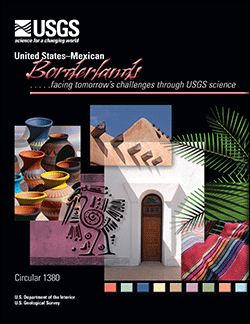A geographic encyclopedia. Names, descriptions, and characteristics of thousands of places in the world.
 Drawing the line : tales of maps and cartocontroversy
by
Argues that maps can be manipulated to distort the truth, and shows how they have been used for propaganda in international affairs, political districting, and finding toxic dump sites.
Drawing the line : tales of maps and cartocontroversy
by
Argues that maps can be manipulated to distort the truth, and shows how they have been used for propaganda in international affairs, political districting, and finding toxic dump sites.
 The Tennessee Locator
by
The Tennessee Locator
by
 United States-Mexican Borderlands: Facing tomorrow's challenges through USGS science
by
Along the nearly 3,200 kilometers (almost 2,000 miles) of the United States–Mexican border, in an area known as the Borderlands, we are witnessing the expression of the challenges of the 21st century. This circular identifies several challenge themes and issues associated with life and the environment in the Borderlands, listed below. The challenges are not one-sided; they do not originate in one country only to become problems for the other. The issues and concerns of each challenge theme flow in both directions across the border, and both nations feel their effects throughout the Borderlands and beyond. The clear message is that our two nations, the United States and Mexico, face the issues in these challenge themes together, and the U.S. Geological Survey (USGS) understands it must work with its counterparts, partners, and customers in both countries.
United States-Mexican Borderlands: Facing tomorrow's challenges through USGS science
by
Along the nearly 3,200 kilometers (almost 2,000 miles) of the United States–Mexican border, in an area known as the Borderlands, we are witnessing the expression of the challenges of the 21st century. This circular identifies several challenge themes and issues associated with life and the environment in the Borderlands, listed below. The challenges are not one-sided; they do not originate in one country only to become problems for the other. The issues and concerns of each challenge theme flow in both directions across the border, and both nations feel their effects throughout the Borderlands and beyond. The clear message is that our two nations, the United States and Mexico, face the issues in these challenge themes together, and the U.S. Geological Survey (USGS) understands it must work with its counterparts, partners, and customers in both countries.
 Getty thesaurus of geographic names
by
"The Getty Thesaurus of Geographic Names (TGN) is a structured vocabulary developed primarily for the field of art history, but with the potential for wide applications in related disciplines such as archeology, history and geography ... The TGN is the only available geographical resource that is both hierarchical and global in scope ... The TGN contains nearly 1 million place names representing approximately 900,000 places"
Getty thesaurus of geographic names
by
"The Getty Thesaurus of Geographic Names (TGN) is a structured vocabulary developed primarily for the field of art history, but with the potential for wide applications in related disciplines such as archeology, history and geography ... The TGN is the only available geographical resource that is both hierarchical and global in scope ... The TGN contains nearly 1 million place names representing approximately 900,000 places"